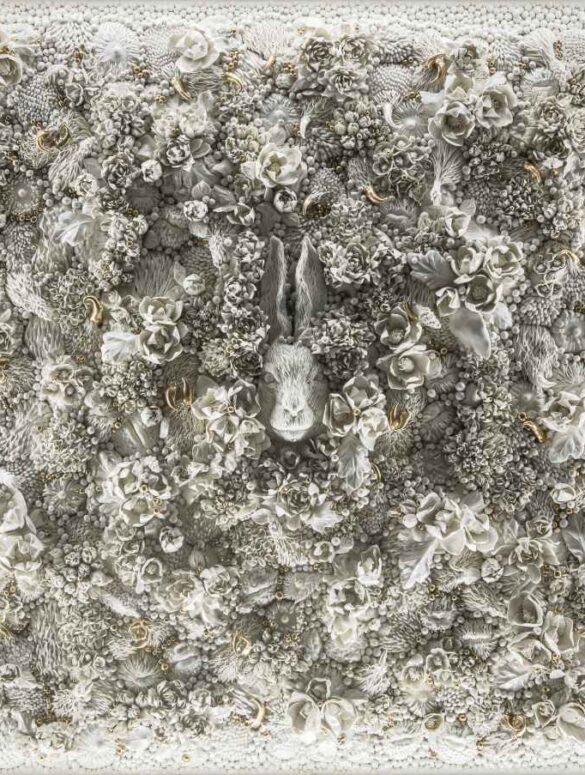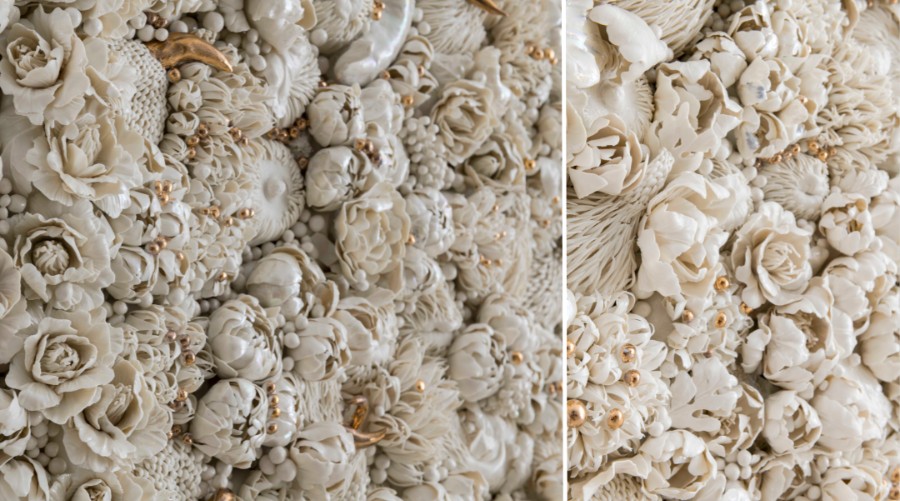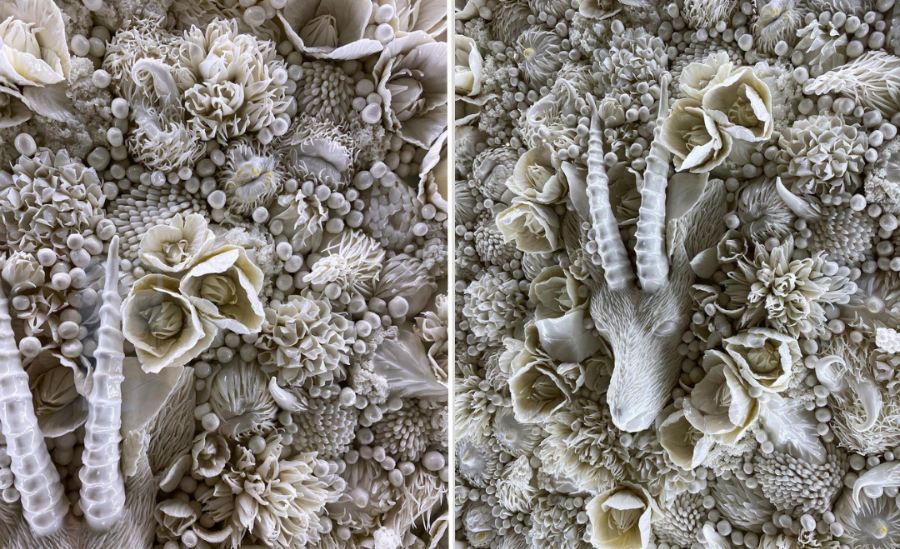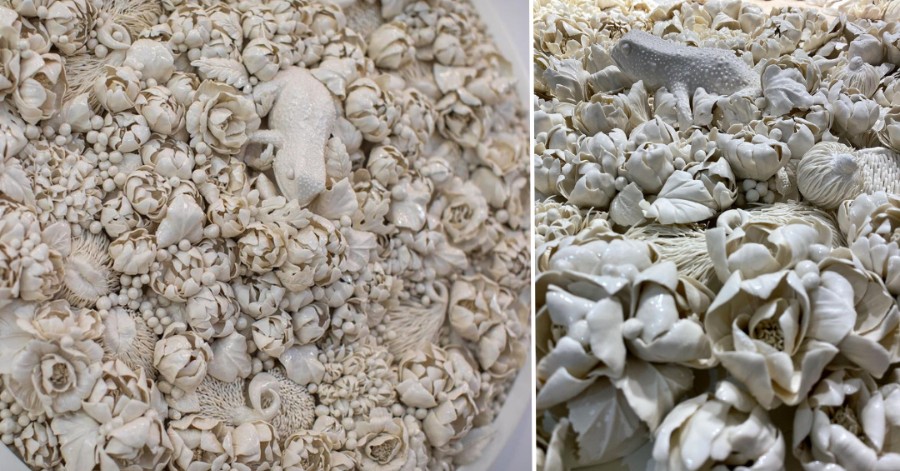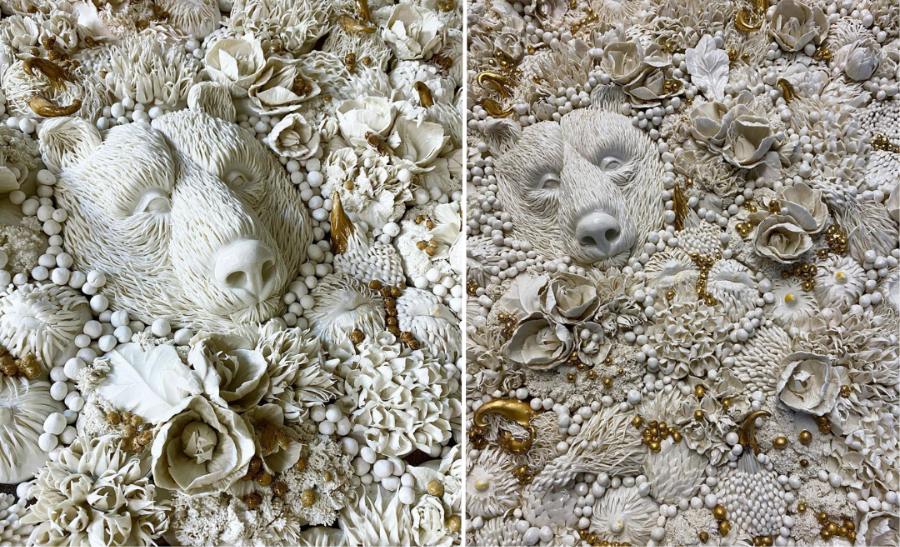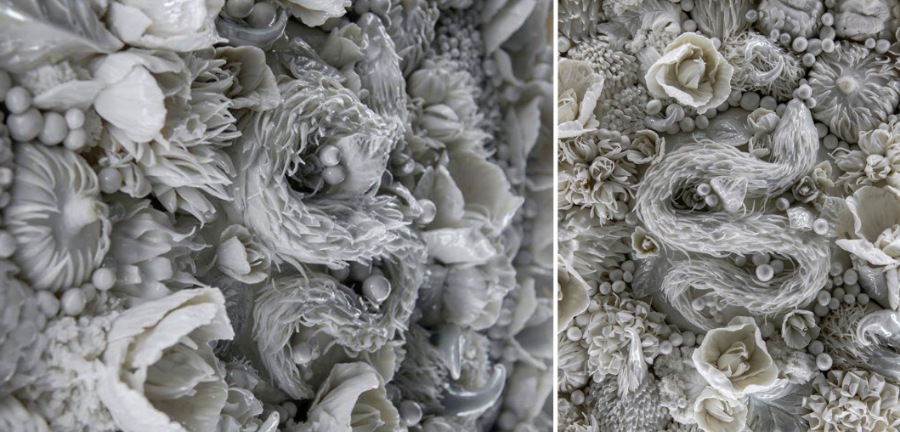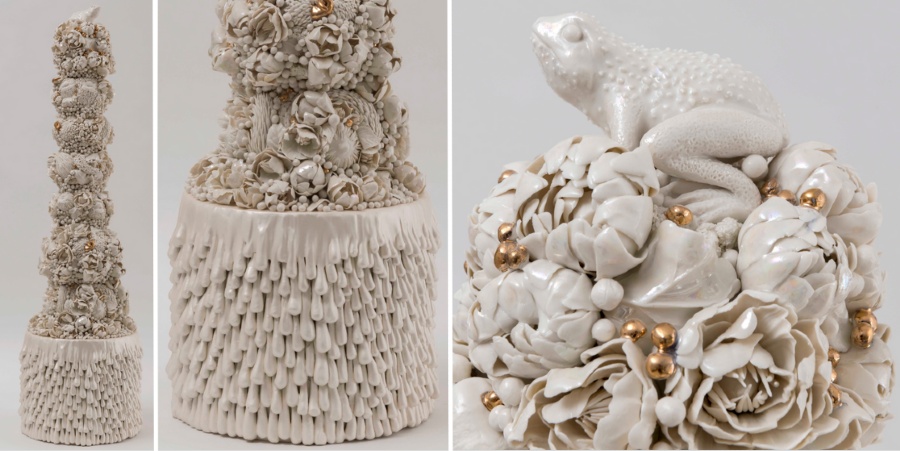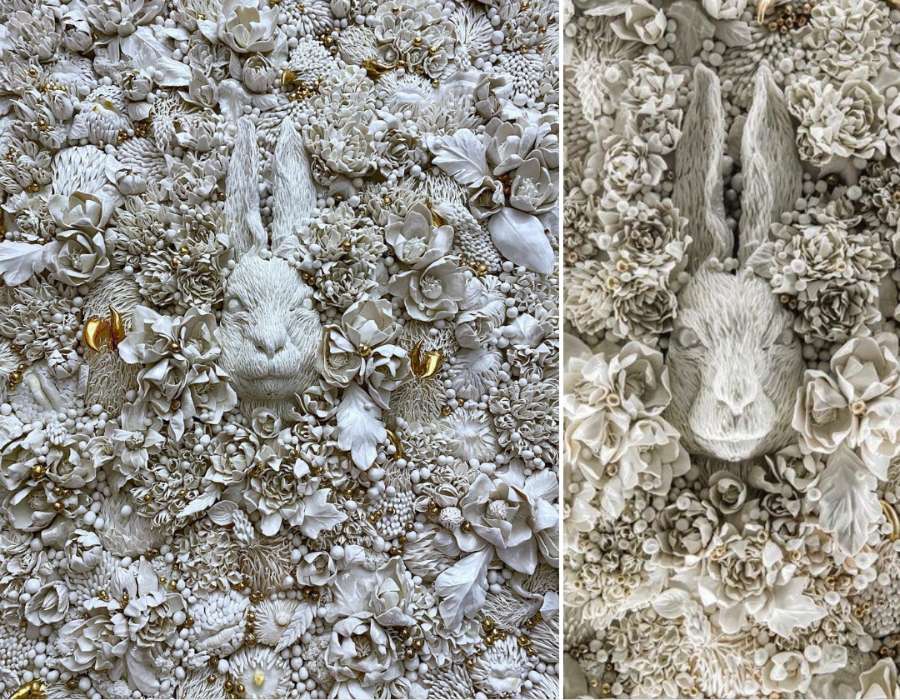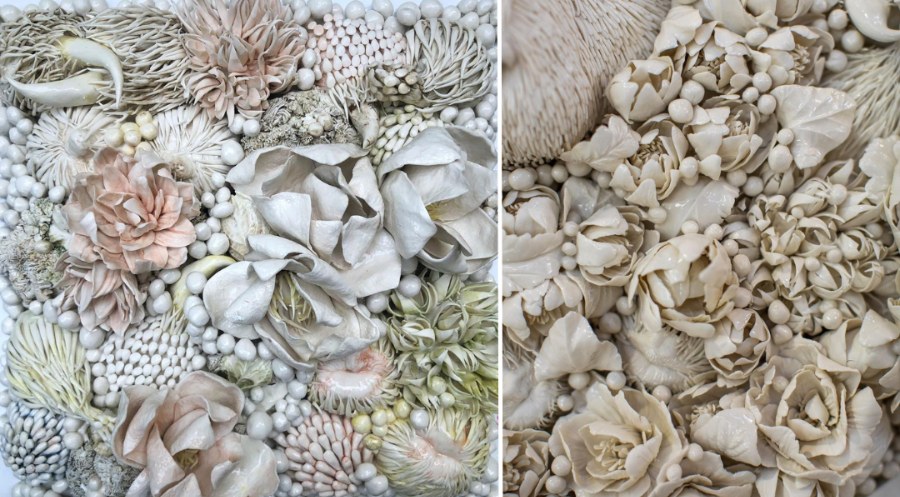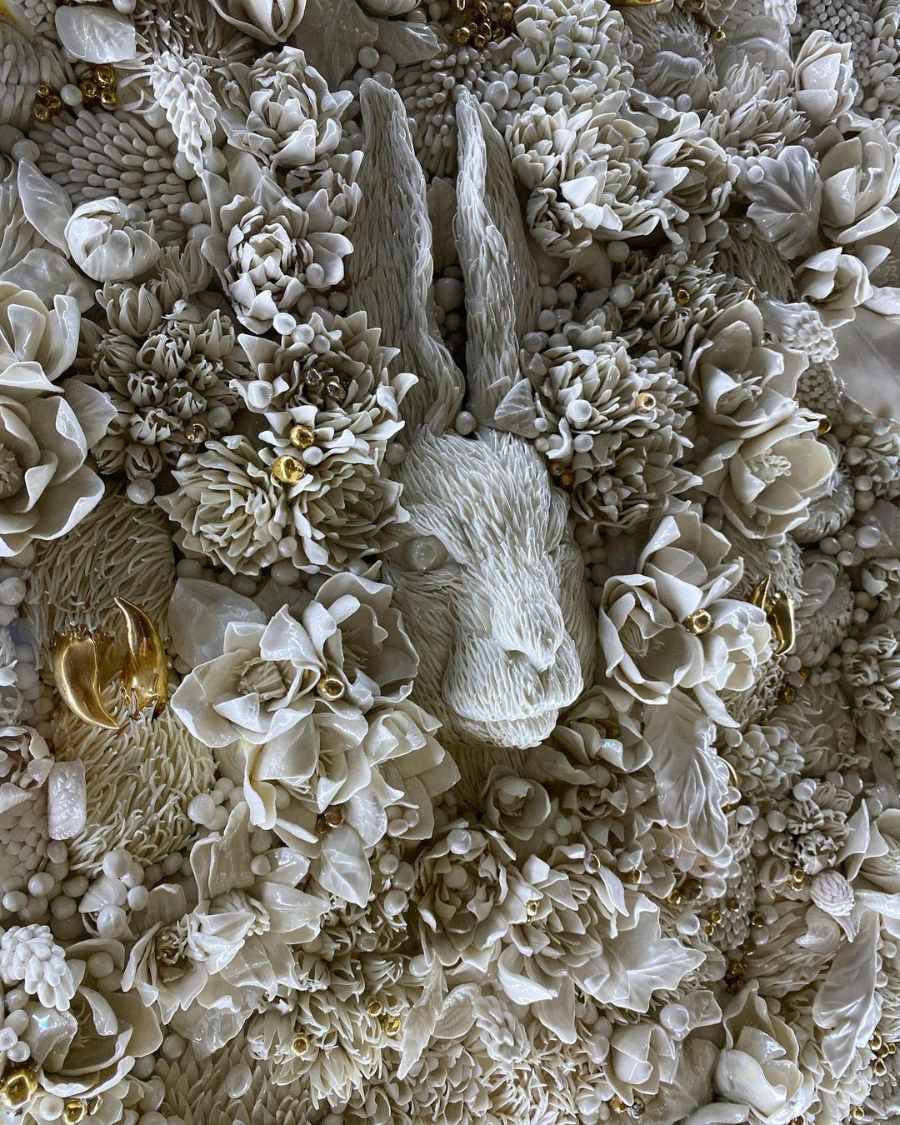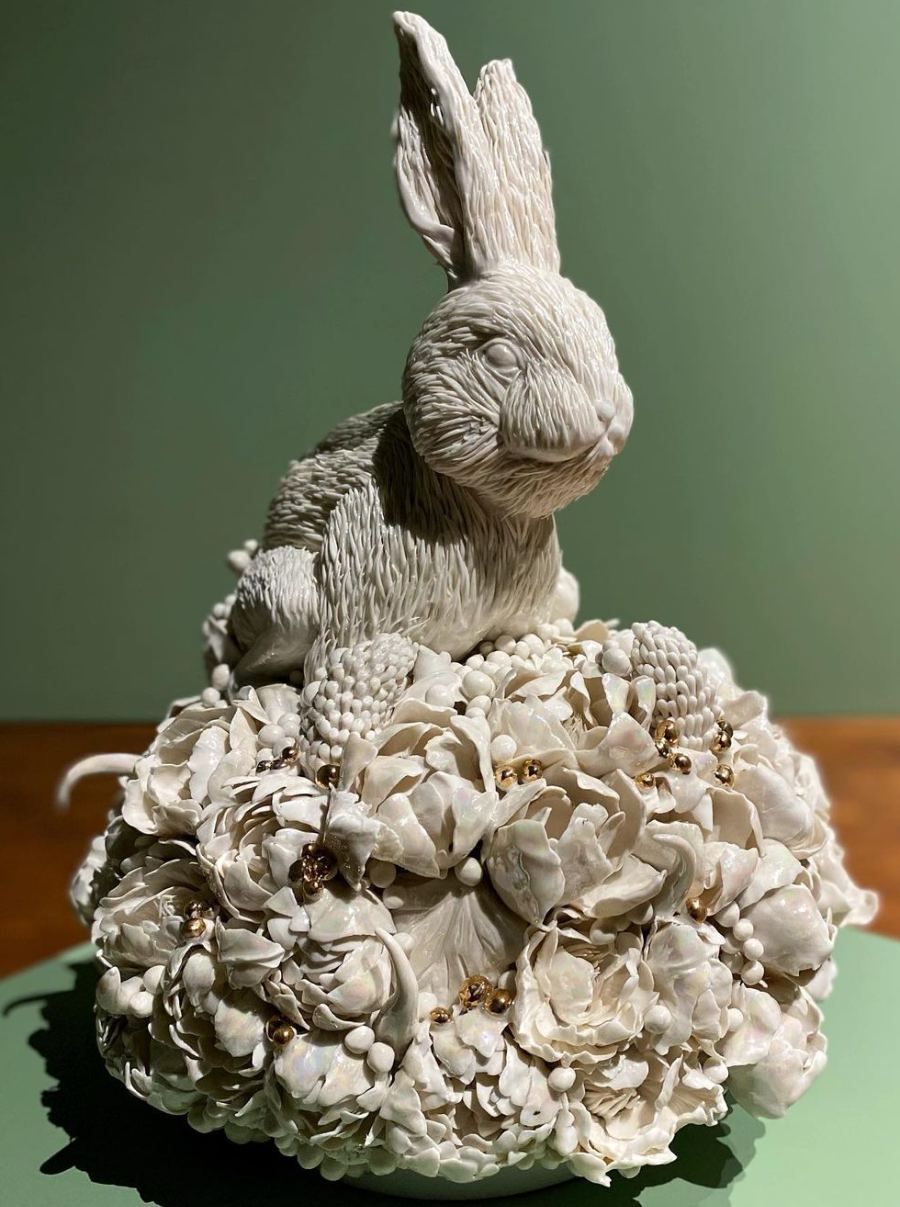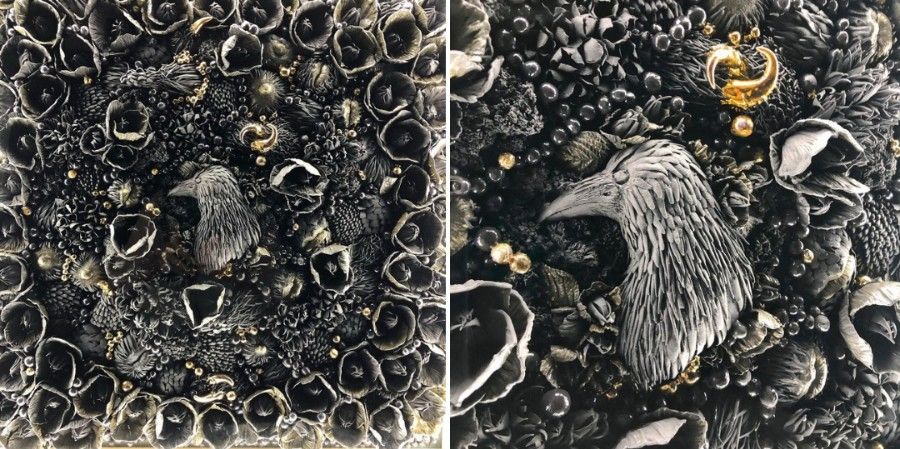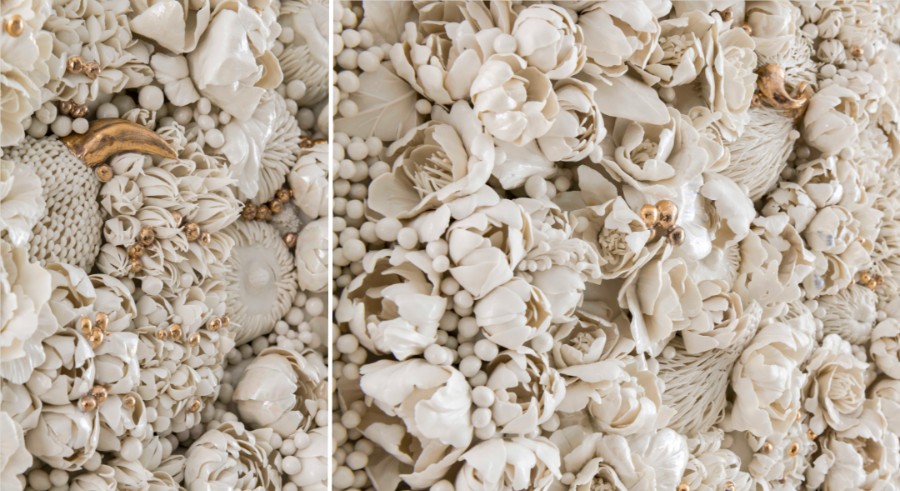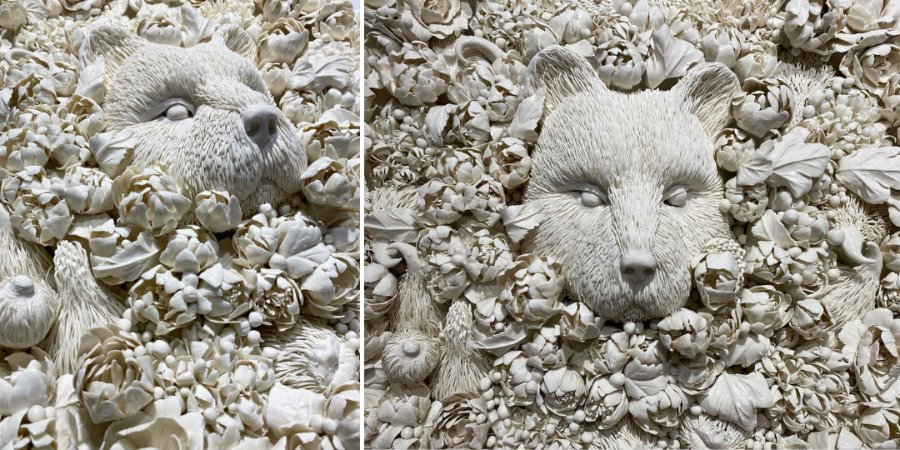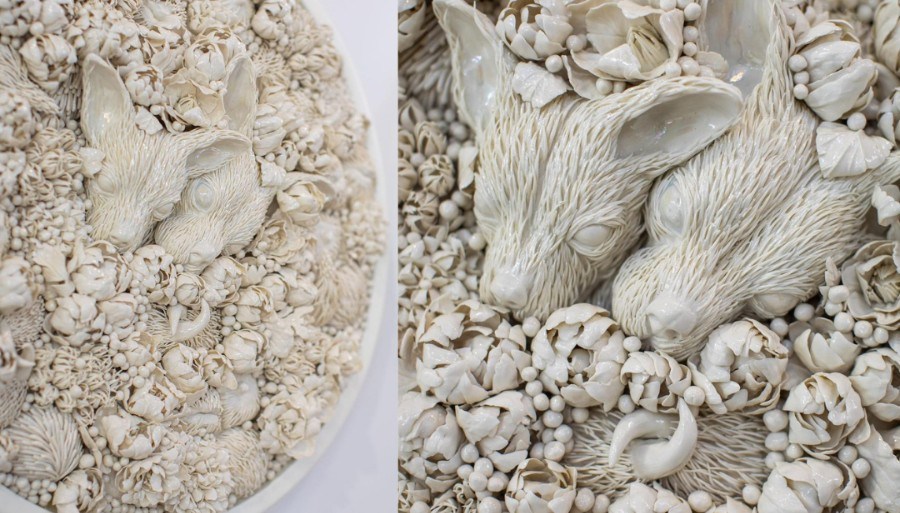Exclusive Interview with Melis Buyruk, 2nd Prize Winner of the Yasha Young Projects Sculpture Award 2021 Beautiful Bizarre Art Prize. Interview conducted by Elizah Leigh.
Melis Buyruk sows every monochromatic millimeter of her textural clay tapestries with botanically diverse, incredulously fragile life forms that are invitingly familiar and – indeed – intriguingly alien. One imagines that the gilded treasures dotting the Gölcük, Turkey-based sculptor’s lippy-nipple-studded porcelain topographies serve as a shimmering lure that captures the attention of every keen-eyed pollinator within a 100-mile radius. Don’t ask how – let’s just go with it.
Each of Melis Buyruk’s individually sculpted golden orbs and – yikes…are those…talons? – presumably enjoy some sort of telepathic and/or wingman symbiosis with the blooms that broadcast their ambrosial fragrance into the swirling winds above. Because…ahhhh, yes – we’ve made a love match! Happy hummingbird, meet deliciously scented, utterly elated flower that will now be able to gracefully expire, knowing that its DNA destiny is fulfilled. Oh…of course…we’ll just give you two some privacy…
Porcelain Nature works in mysterious ways, doesn’t it? You see what just happened, though, don’t you? Study Melis Buyruk’s coral reef-esque microcosms for a hot minute and up, up, and awaaayyyy we go! Any art viewing experience that triggers cerebral synapse fireworks – intellectually, spiritually, or even wackadoodle-narratively – probably boosts our health at a cellular level, but the most irresistible kind is that which piques our curiosity/desire to understand why…and how.
Whatever type of inspiration is surging through your brain at this very moment, Melis’ art is certainly a conversation starter…and indeed we had a lovely one with her. Curious? Then please read on!
If I am not satisfied with my work, I am a perfectionist who will break sections of my sculpture with a hammer. I am also a patient person who will spend many, many hours fixing those areas.
Exclusive Interview with Melis Buyruk
Your childhood affection for creating doll accessories led to a lifelong passion for working with your hands. How did it occur to you that things like that could be made rather than purchased from a store?
Today, those types of items can be found in countless stores, but they were very hard to find in Turkey during the 1980s. When my father would return home from international business trips, he gave me doll accessories, but I always wanted more of them…so I just decided to make them myself!
No one taught you how to make the clothing and accessories for your dolls? You just figured it all out by yourself?
Yes, I created the designs entirely without guidance from others. Sometimes the fashions that I saw actresses wearing in movies served as the inspiration for my own creations. I recall spending many amazing days in the peaceful environment of my grandmother’s house while creating tiny dresses and accessories.
During your formative years, did that specific hobby foretell your destiny as an artist, or did you engage in other creative stepping stones? Could you have just as easily become an oil painter or a digital collagist?
Yes, that hobby was absolutely a huge neon sign that pointed toward my future path! When I was a child, my main desire was to be a fashion designer ‘when I grew up’. Although I didn’t follow that particular career, I always knew that I would end up creating something as my life’s work. In my third year at university, I had a pretty good idea that sculpture was my calling, which is why I decided to focus specifically on ceramics.
What is the best way to describe what you do? Are you a sculptor? A ceramicist? A potter? Or an artist?
I understand why it is so confusing. Since I use clay as my main medium and I create conventional and wall sculptures, does that make me a ceramicist or a sculptor? I always describe myself as an artist who happens to work with porcelain clay.
I always want to explain my artistic narrative in a way that underscores the importance of beauty in my works. That is why I always use 18k gold luster in my sculpture, which makes it significantly more costly, imbuing it with added value.
You’ve worked with various types of sculptural mediums throughout the years, including Audrey Blackman clay and Limoges. Why is porcelain the material that you find so consistently appealing?
I started to work with ceramics but then I discovered just how much I appreciated rendering details, which can be more easily achievable with porcelain clay. Even though that material is approximately ten times more expensive than conventional clay (since it is imported from France), I like its delicacy. The forms that I tend to create are quite fragile though, so that’s why I contain them in protective frames made of glass or plexiglass. That’s really the main reason why I began working with epoxy clay – it is much more durable.
Since porcelain is made with kaolin – and kaolin is a very popular ingredient in natural skincare – are your hands always silky smooth?
The answer to this question is a big NO ?! If only I could show you my hands so you can see what I’m talking about. Clay absorbs the moisture from skin, so sadly, my hands are getting drier day by day. I need to use special hand masks and extra hydrating moisturizers like shea butter to restore my skin.
Your three dimensional floral and fauna microcosms are quite complex, bursting with other-worldly (and earthly) life thanks to a dizzying tapestry of details. Are you a creative perfectionist? A naturally patient person?? Both?
🙂 I think I am both! If I am not satisfied with my work, I am a perfectionist who will break sections of my sculpture with a hammer. I am also a patient person who will spend many, many hours fixing those areas.
You fill every one of your rectangular sculptural panels – which generally measure 1 square meter/10.76 square foot – with extraordinarily lush elegance. It is obvious that they share one thing in common with Rome – they were clearly not built within a day. What does it take to bring one work of art to fruition?
I work in my studio a minimum of 8 hours a day – every day – and the average sculpture takes approximately 1 to 1 ½ months to complete.
I think that juxtaposing our age-old, biologically rendered fear with our socially conditioned admiration for flowers is an interesting notion.
It seems hard to fathom how fingers and hands can manifest the minute details that are a hallmark of your botanical flourishes. Now that we understand how long an entire sculpture takes to complete, what time commitment is necessary to create thousands of hand-rolled spheres or fluttery petals?
My fingers are on autopilot – they are like machines that dominate the clay – so it actually takes me just a few hours.
One might imagine that after a while, even the most creative individual might run out of unique ways to make porcelain plant matter look fresh. How do you ensure that you don’t end up repeating yourself?
I work really hard trying to find new details, shapes, forms and displaying methods so that my sculptures always look original rather than repetitive. Lately, I’ve been integrating new colour details which I believe will create some positive changes to my aesthetic.
I am very sorry that there is not much I can do beyond highlighting environmental issues with my creative output and making small, well-intentioned modifications to my personal lifestyle.
When you methodically place individual hairs onto the face of a porcelain tiger or hand-rolled feathers onto a hawk’s body, is that a tedious task or is it creatively cathartic? Where does your mind go in those moments?
That is actually my favourite part! When I work on those details, I typically listen to podcasts or tv series at the same time. It is like a form of meditation for me.
In order to ensure that all of the fine details in your compositions grip your sculptural topography, you use tools that might seem at home in a surgeon’s office. With all of the practice you’ve had throughout the years exercising such a steady hand, has that skill paid off in other areas of your life (fake eyelash application comes to mind)??
I’ve never tried that, but I am sure that I would be able to use my special skills to make traditional Turkish stuffed meatballs, which is a challenging food to prepare!
Some of your porcelain fields look so fragile that it’s hard to imagine how they make it to the firing stage without accidentally smashing to smithereens. How do you ensure that your work makes it through to completion?
Like a puzzle, I number and then fire each component of my sculpture. The next step is to assemble the individual pieces one by one into a cohesive work of art. Finally, I anchor all of the sculptural elements inside of my frames.
I distort botanical and wildlife components, producing hybrid forms that look somewhat familiar but don’t exist.
Do any of your sculptural works come together simply through spur of the moment creation, or do you always pre-sketch them first?
I always pre-sketch them first, but during the creation process, the details inevitably change.
While engaged in the sculptural process, have you ever had an abrupt change of heart and completely strayed from your initial concept? If so, do you prefer those sculptures more or less than works that consistently adhere to your creative framework?
One time, I created some sketches of a rabbit-themed wall sculpture for a show in Istanbul. When I started to work on it, though, I loved the rabbit so much and decided that I really didn’t want to crop it. That’s why I ended up creating a freestanding rabbit sculpture, instead.
Your sculptural subject matter is largely inspired by realistic (as well as imagined) flora and fauna species. Do the botanical and wildlife components in your sculptures emerge from your mind’s eye or do you generally use visual references?
I think both. I distort the botanical and wildlife components, producing hybrid forms that look somewhat familiar but don’t exist.
In the past, your flora and fauna topographies were intentionally devoid in color. Non-hierarchical hybridity was your reason. Did consistently working in white cause you to become a color addict outside of the studio?
No, in fact, my wardrobe is generally all black with just a small bit of white 🙂 However, lately, I’ve been very eager to make a pink sculpture. Perhaps that creative exercise will bring more colour into my life.
I like including very unexpected and surprising body parts underneath flowers and leaves for the viewer – who thinks they’re looking at a beautiful porcelain wall sculpture – to discover.
What motivated your decision to inject your typically neutral sculptural fields with gold accents?
I always want to explain my artistic narrative in a way that underscores the importance of beauty in my works. That is why I always use 18k gold luster in my sculpture, which makes it significantly more costly, imbuing it with added value.
Some of the elements you’ve included in your sculptures trigger humanity’s innate fear response. Those with a trained eye can detect – among many other curious discoveries – tarantulas, curling talons, fangs, and tusks jutting out of your porcelain landscapes. There is probably a deeper reason for those sculptural flourishes than merely just shock value, right?
Certain animals pose a serious threat to human evolution, which has been engraved in our DNA. We find some creatures uncomfortable or frightening because of their shape or color, and that engages our flight response. I think that juxtaposing our age-old, biologically rendered fear with our socially conditioned admiration for flowers is an interesting notion.
Exotic blossoms with puckered human lip and nipple centers generally aren’t a common sight in porcelain. You mentioned your intent to reference fertility, but – by offering the beholder so many unexpected objects to discover in your art – are you also inviting them to play a game?
Yes, that is the point and my main goal! I like including very unexpected and surprising body parts underneath flowers and leaves for the viewer – who thinks they’re looking at a beautiful porcelain wall sculpture – to discover.
Is this subject matter so deeply embedded into your practice that you can’t imagine sculpting anything else?
I certainly have new ideas about how I might move my artistic practice in the future – who knows – maybe I’ll go in a radical direction! For now though, yes, I am very connected to my current creative themes.
What do your closest family members think about your sculptures? Do they think that you’re a bit of an oddball?
I am so lucky that my family has always been very encouraging of my unconventional creative expression – especially my husband! – but still, he definitely thinks that I’m weird.
Your extraordinary porcelain worlds seduce the beholder to lean in closer and explore. Beyond the sheer beauty of your craft, however, it seems like your work is designed to be a visual eco-icebreaker. Do you hope that beholders – upon experiencing your sculptures – will think about what they might personally do to become a part of the solution?
There is a pervasive injustice in the climate crisis. Underdeveloped countries that have contributed the least to the problem, and – of course, wildlife – are paying the real price rather than the global regions that focused on profit rather than consequence. By using the internet, air conditioning, and consuming meat, I realize that I am contributing to the problem, too.
I am very sorry that there is not much I can do beyond highlighting environmental issues with my creative output and making small, well-intentioned modifications to my personal lifestyle. But I hope that does inspire thought.
I work really hard trying to find new details, shapes, forms and displaying methods so that my sculptures always look original rather than repetitive.
You seem to care a great deal about shining light on ecological subject matter. When you worked on your 2007 dissertation, you even focused on the far-reaching consequences of marine pollution. Does that make you an eco-artivist?
I regard myself as an artist who is interested in the relationship between humankind and nature. My dissertation work – which is included in Istanbul’s Rahmi M. Koç Museum – enabled me to comprehend the devastating impacts of climate change and pollution upon the ocean and marine-based lifeforms. It solidified my connection to nature and my realization that I am a part of nature. We tend to forget that we really do belong to nature. As a human, it makes me sad to think about what we’ve done to our planet.
So many of your works look like shallow graves. What are your porcelain creatures saying to the beholder?
Please remember us. We look beautiful, don’t we?
It certainly seems as though you possess an unwavering passion for your craft. Is clay the greatest thing that ever happened to your life?
There is no plan B for me. I am really at the beginning of my career but am extremely self-motivated. I am working so hard on multiple projects, exhibitions, and international art fairs among many other things. I love it.
Congratulations on winning Beautiful Bizarre Magazine’s 2021 Yasha Young Projects Sculpture Award (2nd Prize)! We were thrilled that our judges selected you and definitely approve of their good taste. What motivated your decision to enter our annual Art Prize?
I have been such a huge fan of Beautiful Bizarre Magazine for years. I’ve loved discovering so many new, interesting artists! I thought that by entering Beautiful Bizarre Magazine’s Art Prize, perhaps my work might reach more people.
We are always interested in learning what our participants think of the Beautiful Bizarre Magazine Art Prize experience. Have you gained anything in particular?
It was a honour to be selected and I believe that this award is really important for any working artist.
Do you believe that other artists might benefit from entering the Beautiful Bizarre Magazine Art Prize? If so, why?
YES! This is such a great opportunity to show your art to a much wider audience – all you need is a cellphone and internet service!
